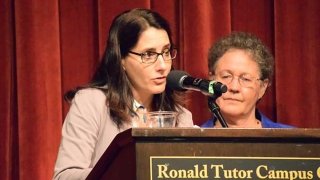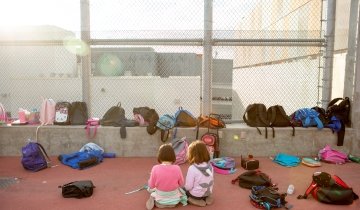Lindsey Richland gives credit to her graduate studies program for helping guide her later scholarship in developmental psychology and cognitive science.
Now a research associate professor at University of California, Irvine, Richland spent a year of graduate school sitting in on a classroom, getting “a sense of what teachers need, what interesting problems are living out there in everyday classrooms that should be the subjects of research.”
Richland is one of 300 researchers who came to the University of Southern California campus this past week for the biennial conference of the International Mind, Brain and Education Society (IMBES). The society’s goal is to improve collaboration between professionals in biology, education and the cognitive and developmental sciences.
“I think one of the key barriers to education and the actual application of research is that teachers and researchers don’t actually sit in the same room,” Richland said.
Like her, other attendees were focused on the relevance of their work for teachers.
In her opening keynote, Mary Helen Immordino-Yang, a professor of education, psychology and neuroscience at USC Rossier and president of IMBES, told attendees that translating science into the classroom requires more than changing scientific language—it requires discomfort.
“Educators no longer have the luxury of ignoring the science of the brain when making education policy—that’s scary and very difficult terrain to enter into,” Immordino-Yang said. “And for scientists’ work to have a genuine impact on children’s lives, we scientists must get outside of our comfort zones, too, and learn about the context and dynamics in which our work will be applied.”
Building pathways
Immordino-Yang’s words echoed a report she co-authored in September with USC Rossier PhD student Christina Krone and with Linda Darling-Hammond, president of the Learning Policy Institute.
The report, “The Brain Basis for Integrated Social, Emotional and Academic Development,” published by the Aspen Institute, explores the science of how young people’s brains develop in ways that promote or inhibit learning.
For example, things that help build vital neural pathways include social interaction, rich environments, green space, physical activity, mental activity, mindfulness and emotional and cultural well-being. Meanwhile, factors like stress, anxiety, loneliness, sleep disruption, dietary deficiencies, toxins and identity threats impair healthy brain development.
Darling-Hammond said at the IMBES conference that despite scientific evidence, schools still often allow the negative factors to be in play in school policy and administration.
“We’ve had schools in the past year that, in order to get test scores up, eliminated recess. They said, ‘we’re not going to go outside—just sit there in front of your test booklet,'” she said.
The report’s authors call on educators to attend to the development of “the whole child,” and suggest community partnerships that can support the health and wellness of children and their families.
“In the end, I believe that all our efforts will be worth it,” Immordino-Yang said. “It is education that will enable our young people to address every problem facing the world.”





